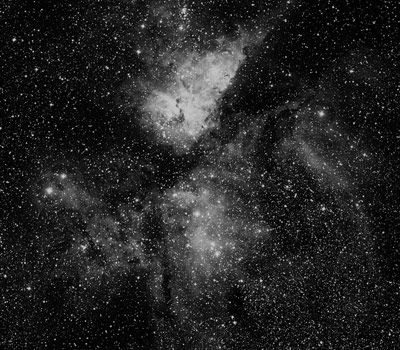When the Defense Department abandoned its high-security satellite-tracking station deep within the Pisgah National Forest in the mid-1990s, neighbors southwest of Brevard continued to believe there were top-secret government activities continuing at the site. Xpress reporter Susan Andrew visited recently to learn more.

10:27 a.m.: My car's alternator abruptly dies along Highway 64 southwest of Brevard. No choice but to pull over.
10:31 a.m.: State trooper pulls up with lights flashing. (I've never been so happy to see those blue lights in my rearview mirror.)
10:32 a.m.: Leaving my car behind, we're off to the Pisgah Astronomical Research Institute, some eight miles away.
"Do you have a security clearance?" the trooper asks. "Last I knew, we'd have to clear the guard at the gate. My Dad and I helped pour the concrete slab that big telescope sits on, years ago."
"We should be able to drive right in," I reply. "This operation is run by a nonprofit foundation now."
"I live just a few miles from here," he says, shaking his head. "We still see the black Apache helicopters heading this way sometimes." He chuckles. "The government is still doing something secret over here."
To the trooper's evident surprise, however, we pass the empty, dusty-looking guardhouse. He drops me off as we're approached by Christi Whitworth, the nonprofit's education director. "You made it!" she says warmly.
More and more visitors are coming to PARI these days, thanks to the facility's numerous public programs. Today they're hosting a group of Rutherford County high schoolers. And on Friday, June 11, as part of the "Evenings at PARI" series, the public can tour the site, hear a presentation by PARI staff and, if the sky is clear, have a look at celestial bodies through one of their high-quality optical telescopes. Visitors can also get their picture taken with one of the towering, 26-meter radio telescopes.
"We'll present a behind-the-scenes look at how astronomers imaged the night sky long before the dawn of the digital camera," explains Thurburn Barker, director of PARI's Astronomical Photographic Data Archive. "Guests will have a chance to examine the plates and films first hand, some of which were taken by notable astronomers, and used to develop our modern view of the universe."
Founded in 2007, the ambitious project aims to digitize a vast collection of celestial images, captured over many decades on glass plates and films. More than 100,000 photos have been collected from across the country, at risk due either to decay or simply because as their owners retire and pass away, those left behind may not recognize their value.
The archive fields requests from astronomers worldwide seeking historical data to complete their studies. The effort to convert all those analog images to computerized digital files is proceeding slowly with the help of two huge Gamma II scanners, each weighing 3.5 tons, donated by the Hubble Space Telescope program. Once used to produce a star catalog that helped steer the Hubble, the scanners were about to be mothballed by NASA when PARI discovered and was able to acquire them simply by paying the shipping.
The remote site's lack of light pollution and radio interference made it perfect for a state-of-the-art tracking station, and NASA established the facility in 1962. In 1981, it was transferred to the Defense Department, which used it to collect satellite data. But in 1995, those operations were consolidated elsewhere, and the 200-acre campus and its 30 buildings mostly stood empty.
The government eventually decided to dismantle the facility, intending to walk away from an investment of some $200 million in property and infrastructure. But Greensboro businessman Don Cline led the effort to save the facility for public science education and research. A separate nonprofit foundation was organized to raise funds for upgrading the equipment, including $2 million worth of electronic drives and computer controls for the huge radio telescopes.
"We've been identified by the International Astronomical Union as the prime location for storing astronomical photographic plates," reports David Clavier, PARI's vice president of administration and development. "That's the group that recently determined Pluto is not a planet. Great discoveries lie in wait on those plates. This is going to be a national story."
Clavier is thrilled about both the photo project and PARI's outreach to students, amateur astronomers and the general public. It's hard not to get cosmic about an effort like this, he says. Describing the big radio telescopes, which can "see" objects in space hundreds of millions of light years away, he notes, "Over such great distances, at some point, space becomes time."
Science Director Michael Castelaz agrees. "Modern astronomy's history is recorded on plates and films that span more than 130 years," he explains. "The data are precious, because we cannot go back in time and image the sky. We only have images taken by previous generations of astronomers."
As for PARI, Castelaz adds, "We don't want to be a secret — we want people to know what's here in their backyards."
Reservations are required for the June 11 "Evening at PARI" ($20 adults, $15 seniors/military, $10 children under 14). You can book at http://pari.edu until 3 p.m. the day of the event. The institute will also host a star party Sept. 8-13, 2010; see details online.
Astronomy buffs might also want to check out these additional sites:
• Current sky map: http://skymaps.com/downloads.html
• Stellar classification: http://scope.pari.edu
• CitizenSky: http://citizensky.org
• Globe at Night: http://globe.gov/GaN/
• Great Worldwide Star Count: http://windows.ucar.edu/citizen_science/starcount/
• Galaxy Zoo http://galaxyzoo.org/
• Stardust@Home: http://stardustathome.ssl.berkeley.edu/
Send your environmental news to sandrew@mountainx.com or call 251-1333, ext. 153.



Former Xpress Managing Editor Jon Elliston contacted us to point out that PARI’s facility was operated by the super-secret spy-operation National Security Agency from 1981-1995, not NASA.
For the whole story, see Elliston’s article on PARI’s fascinating past at http://www.mountainx.com/news/2004/0609spy.php
PARI history (documented in their own handouts) has the Defense Department taking over from NASA in 1981. The super-secret NSA is a division of the Defense Department.